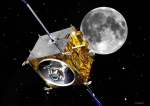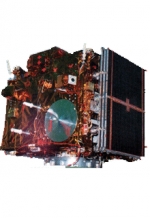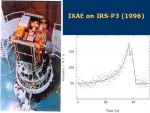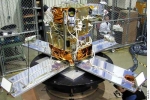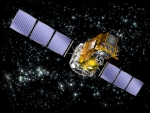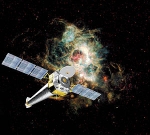Displaying items by tag: X_ray
Suzaku satellite
Suzaku (formerly ASTRO-EII) is a Japanese X-ray astronomy satellite.
It was launched on 10 July 2005 aboard the M-V-6 rocket. The project was renamed Suzaku after its successful launch after the mythical Vermilion bird of the South.
Suzaku is carrying high spectroscopic resolution, very wide energy band instruments for detecting signals ranging from soft X-rays up to gamma-rays (0.3–600 keV). High resolution spectroscopy and wide-band are essential factors to physically investigate high energy astronomical phenomena, such as black holes and supernovae. One such feature, the broad iron K line, may be key to more direct imaging of black holes.
Just weeks after launch, on 29 July 2005 the first of series of cooling system malfunctions occurred, that ultimately on 8 August 2005 caused the entire reservoir of liquid helium to boil off into space. This effectively shut down the XRS which is the spacecraft's primary instrument. The two other instruments, XIS and HXD, were unaffected by the malfunction, and there are plans (Oct. 2013) to integrate another XRS into the proposed NeXT X-ray observation satellite planned for launch in 2014.
FOXSI mission
The Focusing Optics x-ray Solar Imager (FOXSI) is a sounding rocket payload to test hard x-ray (HXR) focusing optics and position-sensitive solid state detectors for solar observations.
The mission is funded under the NASA Low Cost Access to Space program. The FOXSI project is led by the Space Sciences Laboratory at the University of California, Berkeley. The NASA Marshall Space Flight Center is responsible for the grazing incidence optics, while the Astro-H team at JAXA/ISAS has provided double-sided silicon strip detectors.
FOXSI is a pathfinder for the next generation of solar hard x-ray spectroscopic imagers. Such observatories will be able to image the non-thermal electrons within the solar flare acceleration region, trace their paths through the corona, and provide essential quantitative measurements such as energy spectra, density, and energy content in accelerated electrons.

The FOXSI team sits in front of the integrated payload before it gets ready for launch (from left to right: Paul Turin, Shinya Saito, Stephen McBride, Steven Christe, Säm Krucker, Lindsay Glesener). Credit: NASA/S. Fitzpatrick
Previously, techniques to collect and observe the high energy x-rays streaming from the sun were hampered by the fact that x-rays at high energies cannot be focused with conventional lenses the way visible light can be. When an x-ray encounters a standard glass lens it passes through the lens completely. X-ray telescopes have therefore relied on imaging that doesn't rely on focusing. This is a very effective technique when looking at a single bright event on the sun, such as the large burst of radiation and x-rays from a solar flare, but doesn't work as well when searching for many faint events occurring simultaneously.
The FOXSI instrument, however, makes use of new iridium-coated nickel/cobalt mirrors that do successfully cause x-rays to reflect, as long as the x-rays come in from a nearly horizontal direction. Several of these mirrors in combination help collate the x-ray light before funneling it to the detector. These focusing optics make faint events appear brighter and crisper.
SMART-1
SMART-1 was the first European Lunar mission and a technology demonstrator of Deep Space Electric Propulsion.
It was launched in October 2003, reached the moon observation orbit in 2005 and carried out lunar science experiment till controlled crash on the lunar surface in September 2006.
IRS-P3
IRS-P3 is an Indian experimental Earth Observation mission, considered to be pre-operational and serving in parallel for technology evaluation and scientific methodology studies.
It was launched by PSLV-D3 on March 21, 1996 from SHAR Centre, Sriharikota, India. IRS-P3 carries two remote sensing payloads - Wide Field Sensor (WiFS) similar to that of IRS-1C, with an additional Short Wave Infrared Band (SWIR) and a Modular Opto-electronic Scanner (MOS). It also carries an X-ray astronomy payload and a C-band transponder for radar calibration.
Mission completed during January 2006 after serving 9 years and 10 months.
IXAE
The X-ray Astronomy Experiment (IXAE) is a payload which was launched aboard the Indian Remote Sensing Satellite-P3 (IRS-P3) using a Polar Satellite Launch Vehicle (PSLV) on 1996 March 21.
(see article IXAE observations of the X-ray pulsar XTE J1946+274 )
HETE
The High Energy Transient Explorer (abbreviated HETE; also known as Explorer 79) was an American astronomical satellite with international participation (mainly Japan and France). The prime objective of HETE was to carry out the first multiwavelength study of gamma-ray bursts with UV, X-ray, and gamma-ray instruments mounted on a single, compact spacecraft. A unique feature of the HETE mission was its capability to localize GRBs with ~10 arc second accuracy in near real time aboard the spacecraft, and to transmit these positions directly to a network of receivers at existing ground-based observatories enabling rapid, sensitive follow-up studies in the radio, IR, and optical bands. The satellite bus for the first HETE was designed and built by AeroAstro, Inc. of Herndon, VA; the replacement satellite, HETE-2, was built by MIT based on the original HETE design.
Launch attempts
The first HETE was lost during the launch on Nov.4, 1996. The Pegasus rocket achieved a good orbit, but explosive bolts releasing HETE from another satellite (Argentina's SAC-B) and from its DPAF envelope failed to charge, dooming both satellites. A battery on the third stage of the rocket and responsible for these bolts cracked during the ascent.
A second HETE satellite, HETE-2, was launched on October 9, 2000 in a follow-up mission. It was similar to the first HETE, but replaced the UV camera with an additional X-ray camera (Soft X-ray Camera or SXC) capable of higher localization accuracy than the original X-ray instrument (Wide-Field X-ray Monitor or WXM).
INTEGRAL
INTEGRAL is the first space observatory that can simultaneously observe objects in gamma rays, X-rays and visible light.
The European Space Agency's INTErnational Gamma-Ray Astrophysics Laboratory (INTEGRAL) is an operational Earth satellite, launched in 2002 for detecting some of the most energetic radiation that comes from space. It is the most sensitive gamma ray observatory ever launched.
INTEGRAL is an ESA mission in cooperation with the Russian Space Agency and NASA. It has had some notable successes, for example in detecting a mysterious 'iron quasar'. It has also had great success in investigating gamma-ray bursters and evidence for black holes.
NuSTAR Telescope
Nuclear Spectroscopic Telescope Array (NuSTAR) is a planned space-based X-ray telescope that will use a Wolter telescope to focus high energy X-rays at 5 to 80 keV from astrophysical sources, especially for nuclear spectroscopy. It is the eleventh mission of the NASA Small Explorer satellite program (SMEX-11) and the first space-based direct-imaging X-ray telescope at energies beyond those of the Chandra X-ray Observatory and XMM-Newton.
Mission launch is scheduled for 21 March 2012.
Its primary scientific goals are to conduct a deep survey for black holes a billion times more massive than our sun, understand how particles are accelerated to within a fraction of a percent of the speed of light in active galaxies, and understand how the elements are created in the explosions of massive stars by imaging the remains, which are called supernova remnants.
NuSTAR employs two grazing incidence focusing optics each of which consists of 133 concentric shells. The optics used were coated by DTU Space in Copenhagen and assembled at the Nevis Laboratories of Columbia University.
Partners:
The principal investigator is the California Institute of Technology (Caltech). Other major partners include the Jet Propulsion Laboratory (JPL), University of California at Berkeley, Danish Technical University (DTU),Columbia University, Goddard Space Flight Center, Stanford University, University of California, Santa Cruz,Sonoma State University, Lawrence Livermore National Laboratory, and the Italian Space Agency (ASI). NuSTAR's major industrial partners include Orbital Sciences Corporation and ATK Space Systems-Goleta.
XMM-Newton
The XMM-Newton (X-ray Multi-Mirror Mission - Newton) is an orbiting X-ray observatory launched by ESA in December 1999 on a Ariane 5 rocket. It is named in honor of Sir Isaac Newton.
Its mission is turned towards deep space and aimes to increasing our knowledge of very hot objects created when the Universe was very young,
Originally known as the High Throughput X-ray Spectroscopy Mission it was placed in a very eccentric 48 hour elliptical orbit at 40°; at its apogee it is nearly 114,000 kilometres (71,000 mi) from Earth, while theperigee is only 7,000 kilometres (4,300 mi)
The satellite weighs 3,800 kilograms (8,400 lb), is 10 metres (33 ft) long and 16 metres (52 ft) in span with its solar arrays deployed. It holds three X-ray telescopes, developed by Media Lario of Italy, each of which contains 58 Wolter-type concentric mirrors. The combined collecting area is 4,300 cm². The three European Photon Imaging Cameras (EPIC) are sensitive over the energy range 0.2 keV to 12 keV. Other instruments onboard are two reflection grating spectrometers which are sensitive below ~2 keV, and a 30 centimetres (12 in) diameter Ritchey-Chretien optical/UV telescope.
The mission was proposed in 1984 and approved in 1985; a project team was formed in 1993 and development work began in 1996. The satellite was constructed and tested from March 1997 to September 1999. Launched in Dec 1999, in-orbit commissioning started Jan 2000. First images published Feb 2000. The original mission lifetime was two years, it has now been extended for further observations until at least 2010, and again until 2012, and technically could operate until 2018.
Observations are managed and archived at the European Space Astronomy Centre (formerly known as VILSPA) at Villafranca, Spain. The data are processed at the XMM-Newton Survey Science Centre at the University of Leicester, England.
The European satellite XMM-Newton (X-ray Multi Mirror), built under contract to ESA by a consortium of 35 European companies with Astrium as prime contractor, by far excels its predecessor, the Astrium-built ROSAT satellite.
Chandra X-ray Observatory
The Chandra X-ray Observatory is a satellite launched on STS-93 by NASA on July 23, 1999. It was named in honor of Indian-American physicist Subrahmanyan Chandrasekharwho is known for determining the maximum mass for white dwarfs. "Chandra" also means "moon" or "luminous" in Sanskrit.
Chandra Observatory is the third of NASA's four Great Observatories. The first was Hubble Space Telescope; second the Compton Gamma Ray Observatory, launched in 1991; and last is the Spitzer Space Telescope. Prior to successful launch, the Chandra Observatory was known as AXAF, the Advanced X-ray Astrophysics Facility. AXAF was assembled and tested by TRW (now Northrop Grumman Aerospace Systems) in Redondo Beach,California. Chandra is sensitive to X-ray sources 100 times fainter than any previous X-ray telescope, due primarily to the high angular resolution of the Chandra mirrors.
Since the Earth's atmosphere absorbs the vast majority of X-rays, they are not detectable from Earth-based telescopes, requiring a space-based telescope to make these observations.



